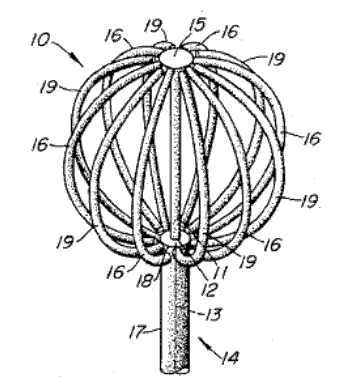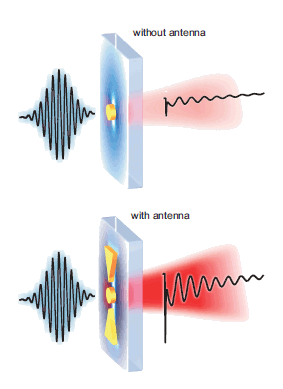Optical Antennas
June 13, 2011
One favorite
engineering book on my bookshelf is "
Antennas" by
John Kraus.[1] Kraus invented the
axial mode helical antenna, and he was a pioneer in
radio astronomy. Antennas (or, antennae, depending on the spelling rules that were drummed into you in
high school) are an important part of
radio receivers and
transmitters, since they couple
electromagnetic signals between
electronic circuitry and "free space," an archaic term for the
vacuum. I wrote about antennas in a
previous article (Antennae, June 28, 2010).
One important rule of thumb in antenna design is that the antenna needs to be about the same dimension as the
wavelength of the
radiation that needs to be transmitted or received. If the antenna is too small, little of the
voltage applied to the antenna couples into free space. Unless certain
electronic trickery is employed, too large an antenna will be less efficient for other reasons. That's why
AM radio towers, which transmit around a frequency of a
megahertz, are more than a hundred meters high, and the
Wi-Fi antenna on your
wireless router (2.45
GHz) is just a few inches long.

A spherical cage antenna invented by John Kraus.
Figure 1 of US Patent No. 2,732,551, "Spherical Cage Antenna," January 24, 1956
The advent of
nanotechnology has opened an interesting application area for antennae. Since
visible light has a wavelength of about 500
nanometers, it's now possible to make a radio antenna that detects light. Not only that, if certain other technologies evolve, we could employ such antennas as
photovoltaic energy sources in devices called
nantennas.
The nantenna idea goes back to the time of the
1970s energy crisis. The essential nantenna idea was contained in a 1973 patent,[2] but technology at the time did not allow a practical implementation. The nantenna
aegis has been picked up again by the
Idaho National Laboratory, a laboratory of the
US Department of Energy.[3] A research group there has demonstrated creation of alternating electrical currents in antennas at the
terahertz frequencies required for
solar energy harvesting. In order to harvest light at wavelengths from 0.4 - 1.6
μm, nantennas must be tuned for a 190 - 750 terahertz frequency range.
The major problem in using nantennas to harvest solar energy is conversion of these extremely high frequency electrical signals to useful
electrical power. Conventional conversion of
AC signals to
DC voltages is by
semiconductor diode rectifiers, but high frequency
Schottky diodes don't perform well at such extreme frequencies. Another possibility is the metal-insulator-metal (MIM)
tunnel diode.
MIM diodes demonstrate the utility of
quantum mechanics. The device consists of metal electrodes of different
work functions separated by a thin
dielectric insulator. Electrons will
tunnel through the insulator, but the difference in work function makes the tunneling easier in one direction than the other.
Since an MIM diode is a tunneling device,
parasitic capacitance, the primary problem of conventional diodes, is not a problem. Efficient MIM diodes have been demonstrated at about 150 terahertz, just outside the range required for a nantenna solar energy collector.[4]
Nantenna solar collectors may be quite a few years into the future, but the use of antennas to process light signals has become common in
optics, as demonstrated in a recent paper in
Nature Communications.[5-6]

A bowtie nanoantenna structure used to concentrate optical signals in a nanoscale object.
The optical signal, including the initial, transient portion, is weak without the antenna (top), but it is amplified by an order of magnitude with the bowtie structure (bottom).
Figure 1 of Ref. 5, (Via arXiv))
As shown in the figure, a resonant optical nanoantenna was used to concentrate the optical field on an individual nanoscale object. This antenna structure gave an order of magnitude enhancement in the optical signals used to probe a single
gold nanoparticle.
This nanoantenna research was conducted by scientists at the Ultrafast Nanooptics Group of the
Max Planck Institute for Solid State Research and the
Physics Institute and Research Center of the
University of Stuttgart (
Stuttgart, Germany).
References:
- J.D. Kraus, "Antennas," McGraw-Hill (New York, 1988).
- James C. Fletcher and Robert A. Bailey, "Electromagnetic Wave Energy Converter," US Patent No. 3,760,257, September 18, 1973.
- Dale K. Kotter, Steven D. Novack, W. Dennis Slafer and Patrick Pinhero, "Solar Nantenna Electromagnetic Collectors," Proceedings of the 2nd International Conference on Energy Sustainability, August 10-14, 2008, Jacksonville, Florida, Report No. ES 2008-54016.
- B. Berland, "Photovoltaic Technologies Beyond the Horizon: Optical Rectenna Solar Cell," Final Report, NREL/SR-520-33263, National Renewable Energy Laboratory, February, 2003.
- Thorsten Schumacher, Kai Kratzer, David Molnar, Mario Hentschel, Harald Giessen and Markus Lippitz, "Nanoantenna-enhanced ultrafast nonlinear spectroscopy of a single gold nanoparticle," Nature Communications, vol. 2, no. 5 (May 31, 2011), article 333.
- Thorsten Schumacher, Kai Kratzer, David Molnar, Mario Hentschel, Harald Giessen and Markus Lippitz, "Nanoantenna-enhanced ultrafast nonlinear spectroscopy of a single gold nanoparticle," arXiv Preprint Server, April 26, 2011.
Permanent Link to this article
Linked Keywords: Electrical engineering; antenna; John Kraus; axial mode helical antenna; radio astronomy; high school; radio receiver; radio transmitter; electromagnetic signal; electronic circuitry; vacuum; wavelength; radiation; voltage; phased array; AM radio tower; megahertz; Wi-Fi; wireless router; GHz; US Patent No. 2,732,551; Spherical Cage Antenna; nanotechnology; visible light; nanometer; photovoltaic; nantenna; 1970s energy crisis; aegis; Idaho National Laboratory; US Department of Energy; terahertz frequency; solar energy harvesting; micrometer; μm; electrical power; alternating current; AC signal; Direct current; DC voltage; diode; Schottky diode; tunnel diode; quantum mechanics; work function; dielectric; insulator; quantum tunnelling; parasitic capacitance; optics; Nature Communications; arXiv; gold; Max Planck Institute for Solid State Research; Physics; University of Stuttgart; Stuttgart, Germany.